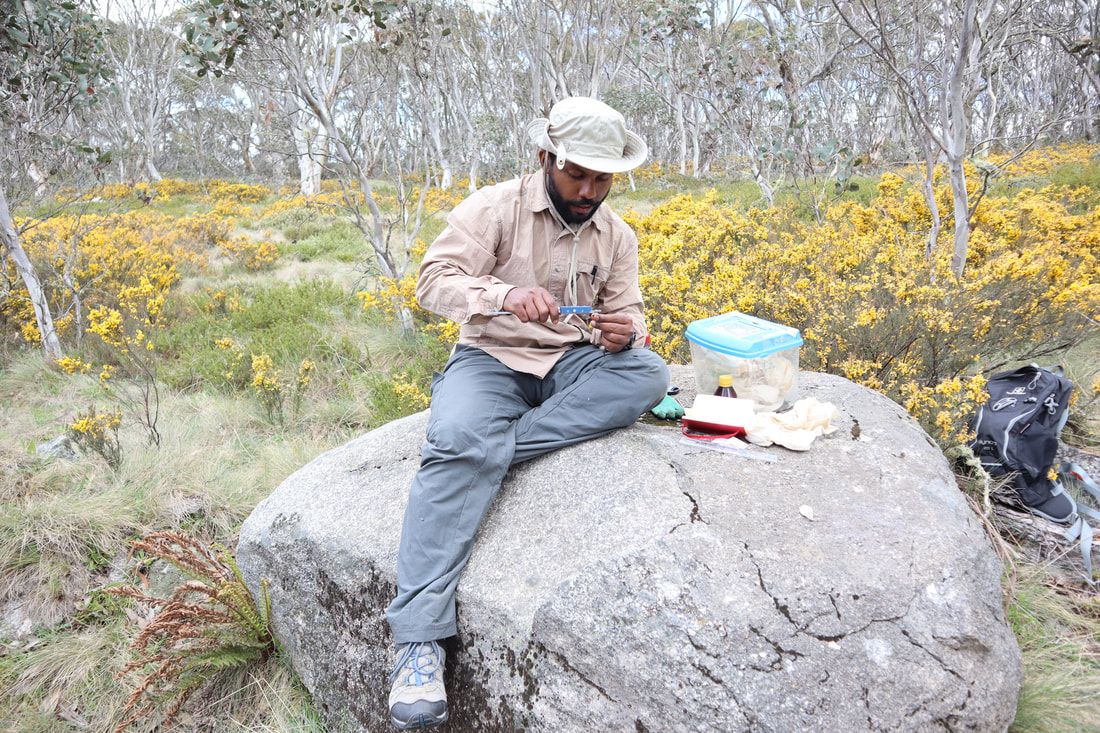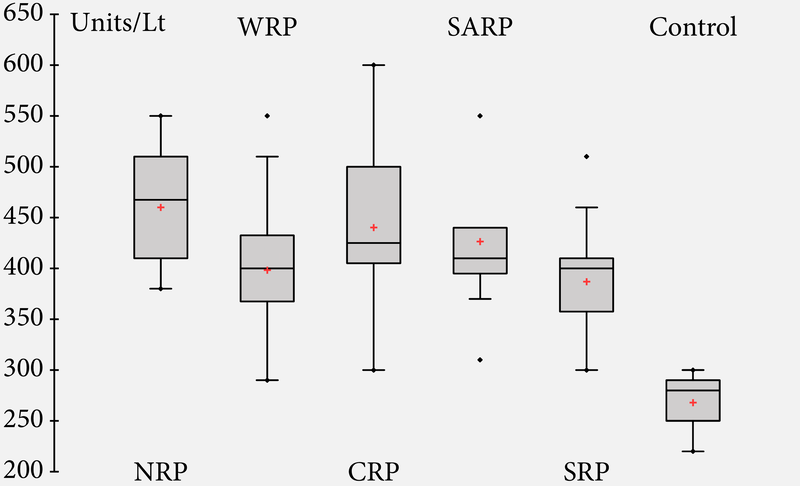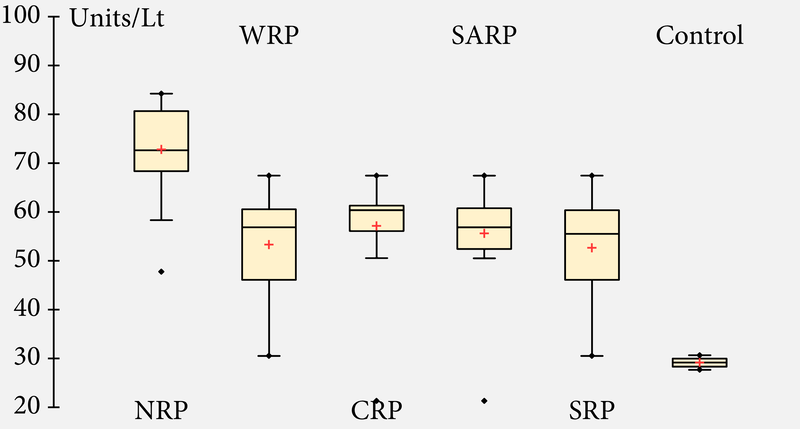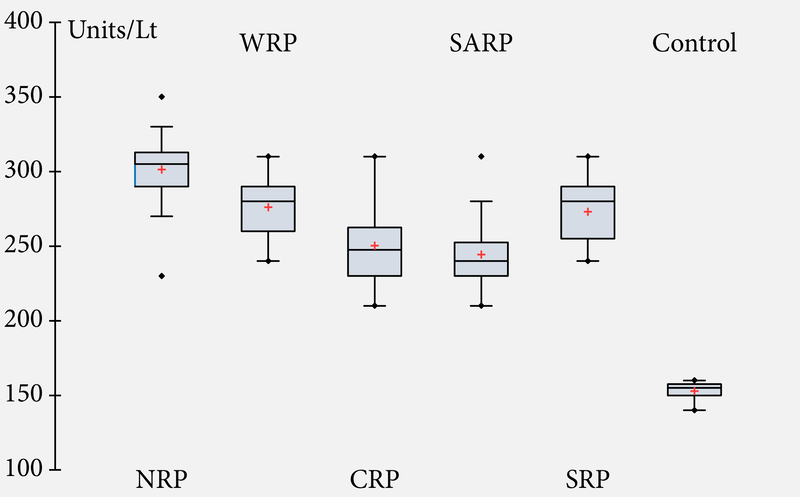"To ensure the survival of all living beings in a rapidly changing environment, we need to adapt our conservation strategies. It's not just about the characteristics of species, but also their ability to adapt to changing conditions that will determine their fate and evolution."
Dr Dumie Dissanayake
I hereby declare that the opinions expressed on this site are solely my own and do not represent the views or official position of my current organization, except for published articles where collaboration is explicitly acknowledged.
As an evolutionary biologist, my primary focus is on contemporary natural selection, which involves integrating field research and molecular studies with theoretical frameworks to better understand the complex mechanisms underlying species adaptation. Currently, my research is centered on the use of ecological, genetic, and genomic principles to investigate the evolution and adaptation of vertebrates in response to changing climatic conditions.
Moreover, my research interests extend to exploring the origin and evolution of species and identifying crucial evolutionary units to resolve critical challenges in species evolutionary biology and their conservation management. By utilizing advanced techniques and interdisciplinary approaches, my goal is to uncover new insights into the fundamental principles governing evolutionary processes and their broader implications for biodiversity conservation.
Moreover, my research interests extend to exploring the origin and evolution of species and identifying crucial evolutionary units to resolve critical challenges in species evolutionary biology and their conservation management. By utilizing advanced techniques and interdisciplinary approaches, my goal is to uncover new insights into the fundamental principles governing evolutionary processes and their broader implications for biodiversity conservation.
Breakthrough Discoveries: Unraveling the Unknown and Trailblazing Research Outcomes
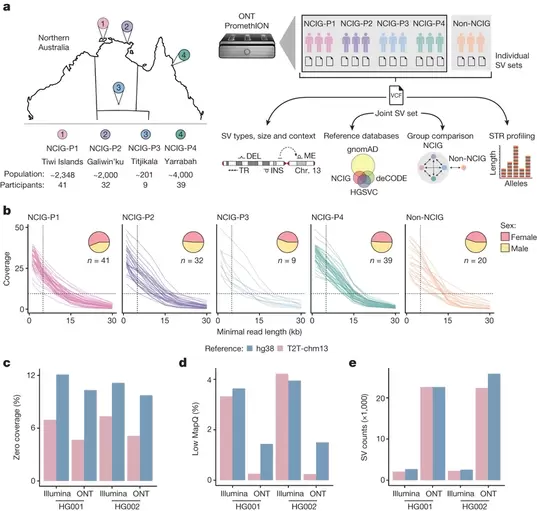
Unveiling the Genomic Mosaic: Exploring Structural Variation in Indigenous Australians - Published in Nature
Australia's Indigenous communities are custodians of a remarkably rich and distinct genomic tapestry. Despite this, the ancestral heritage of Aboriginal and Torres Strait Islander populations has historically been overlooked in genomics research, glaringly absent from reference datasets. Rectifying this discrepancy is imperative, not only for advancing our comprehension of global human genomic diversity but also as a crucial step toward ensuring fairness in genomic medicine outcomes.
In a groundbreaking endeavor, population-scale whole-genome long-read sequencing was employed to delve into the genomic structural variations within four remote Indigenous communities. The findings reveal a plethora of substantial insertion–deletion variants, structural variants, and variable copy number regions, unveiling a previously unseen complexity. Remarkably, a significant proportion of these variants are exclusive to Indigenous Australians, emphasizing the necessity for broad and comprehensive sampling across the continent.
The majority of these variants consist of tandem repeat or interspersed mobile element sequences, with a substantial percentage being previously uncharted. The discovery of novel repeat expansion sites within protein-coding genes and the identification of unique patterns of diversity and constraint among short tandem repeat sequences provide a nuanced understanding of the genomic landscape.
This study not only pioneers the exploration of genomic structural variation within Indigenous communities but also contributes to the broader understanding of genetic diversity both within and beyond the Australian continent. By shedding new light on the dimensions and dynamics of genomic variations, this research not only elevates the importance of Indigenous genomics but also underscores the critical need for inclusive and extensive sampling to construct a comprehensive catalogue of genomic diversity that reflects the true richness of Australia's genetic heritage.
Reis, A. L., Rapadas, M., Hammond, J. M., Gamaarachchi, H., Stevanovski, I., Ayuputeri Kumaheri, M., ... & Deveson, I. W. (2023). The landscape of genomic structural variation in Indigenous Australians. Nature, 1-9.
Australia's Indigenous communities are custodians of a remarkably rich and distinct genomic tapestry. Despite this, the ancestral heritage of Aboriginal and Torres Strait Islander populations has historically been overlooked in genomics research, glaringly absent from reference datasets. Rectifying this discrepancy is imperative, not only for advancing our comprehension of global human genomic diversity but also as a crucial step toward ensuring fairness in genomic medicine outcomes.
In a groundbreaking endeavor, population-scale whole-genome long-read sequencing was employed to delve into the genomic structural variations within four remote Indigenous communities. The findings reveal a plethora of substantial insertion–deletion variants, structural variants, and variable copy number regions, unveiling a previously unseen complexity. Remarkably, a significant proportion of these variants are exclusive to Indigenous Australians, emphasizing the necessity for broad and comprehensive sampling across the continent.
The majority of these variants consist of tandem repeat or interspersed mobile element sequences, with a substantial percentage being previously uncharted. The discovery of novel repeat expansion sites within protein-coding genes and the identification of unique patterns of diversity and constraint among short tandem repeat sequences provide a nuanced understanding of the genomic landscape.
This study not only pioneers the exploration of genomic structural variation within Indigenous communities but also contributes to the broader understanding of genetic diversity both within and beyond the Australian continent. By shedding new light on the dimensions and dynamics of genomic variations, this research not only elevates the importance of Indigenous genomics but also underscores the critical need for inclusive and extensive sampling to construct a comprehensive catalogue of genomic diversity that reflects the true richness of Australia's genetic heritage.
Reis, A. L., Rapadas, M., Hammond, J. M., Gamaarachchi, H., Stevanovski, I., Ayuputeri Kumaheri, M., ... & Deveson, I. W. (2023). The landscape of genomic structural variation in Indigenous Australians. Nature, 1-9.
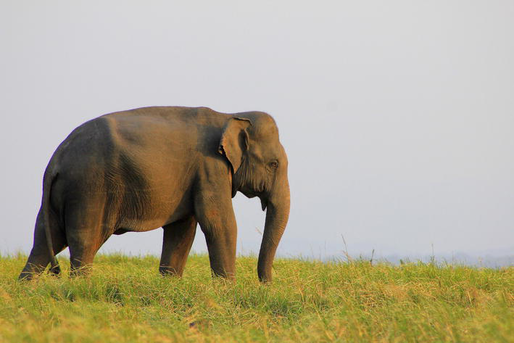
Giants on an Island: Threats and Conservation Challenges of Elephants Due to Herbivorous Diets
Elephants, those majestic and highly adaptable herbivores, traverse a vast dietary spectrum that spans both natural foliage and cultivated crops. Within this expansive dietary canvas, their foraging tactics exhibit a nuanced variability influenced by temporal and spatial factors, as well as the dynamics of distinct social groups. Unlike their counterparts within the confines of national parks, nature reserves, and protected areas, a substantial number of elephants in both Asia and Africa navigate existence in landscapes where human influence looms large. This reality amplifies the challenges these intelligent creatures face, heightening the risks of mortality or injury as they diligently seek essential nutrients.
Within the rich tapestry of their ecological narrative, this chapter unfolds as a profound exploration into the pivotal role played by dry-zone forests as crucial habitats for elephants. These ecosystems, often overlooked in mainstream discourse, emerge as sanctuaries that sustain the intricate balance of life for these enormous creatures. A delicate dance of survival plays out within these habitats, where elephants engage in complex foraging rituals and navigate a landscape that is both provider and potential threat.
Delving deeper into the narrative, the chapter navigates the intricate interplay between elephants and the landscapes dominated by human activity. It unravels the intricate web of influences that shape elephant feeding behaviors and foraging strategies in environments where human and pachyderm coexistence is a daily reality. The symbiotic relationship between these creatures and their human-influenced habitats takes center stage, underscoring the pressing need to elevate our comprehension of these behaviors.
The urgency to grasp the intricacies of elephant behavior becomes apparent as we consider the implications for the future. As human populations expand and encroach upon once-wild territories, elephants find themselves adapting to an ever-evolving landscape. Understanding their foraging strategies, the delicate balance they strike in human-dominated environments, and the consequences of this coexistence is not merely an academic pursuit; it is an imperative for the conservation and sustainable cohabitation of these iconic species.
In conclusion, this chapter serves as a poignant journey through the lives of elephants, unraveling the mysteries of their foraging behaviors and shedding light on the dynamic relationship between these giants and the landscapes they inhabit. As we venture into an era where the boundaries between wilderness and civilization blur, the insights gleaned from this exploration become invaluable, offering a compass to navigate the intricate paths towards ensuring the longevity and well-being of these remarkable creatures in our shared world.
Fernando, C., & Dissanayake, D. S. (2023). Giants on an Island: Threats and Conservation Challenges of Elephants Due to Herbivorous Diets.
Elephants, those majestic and highly adaptable herbivores, traverse a vast dietary spectrum that spans both natural foliage and cultivated crops. Within this expansive dietary canvas, their foraging tactics exhibit a nuanced variability influenced by temporal and spatial factors, as well as the dynamics of distinct social groups. Unlike their counterparts within the confines of national parks, nature reserves, and protected areas, a substantial number of elephants in both Asia and Africa navigate existence in landscapes where human influence looms large. This reality amplifies the challenges these intelligent creatures face, heightening the risks of mortality or injury as they diligently seek essential nutrients.
Within the rich tapestry of their ecological narrative, this chapter unfolds as a profound exploration into the pivotal role played by dry-zone forests as crucial habitats for elephants. These ecosystems, often overlooked in mainstream discourse, emerge as sanctuaries that sustain the intricate balance of life for these enormous creatures. A delicate dance of survival plays out within these habitats, where elephants engage in complex foraging rituals and navigate a landscape that is both provider and potential threat.
Delving deeper into the narrative, the chapter navigates the intricate interplay between elephants and the landscapes dominated by human activity. It unravels the intricate web of influences that shape elephant feeding behaviors and foraging strategies in environments where human and pachyderm coexistence is a daily reality. The symbiotic relationship between these creatures and their human-influenced habitats takes center stage, underscoring the pressing need to elevate our comprehension of these behaviors.
The urgency to grasp the intricacies of elephant behavior becomes apparent as we consider the implications for the future. As human populations expand and encroach upon once-wild territories, elephants find themselves adapting to an ever-evolving landscape. Understanding their foraging strategies, the delicate balance they strike in human-dominated environments, and the consequences of this coexistence is not merely an academic pursuit; it is an imperative for the conservation and sustainable cohabitation of these iconic species.
In conclusion, this chapter serves as a poignant journey through the lives of elephants, unraveling the mysteries of their foraging behaviors and shedding light on the dynamic relationship between these giants and the landscapes they inhabit. As we venture into an era where the boundaries between wilderness and civilization blur, the insights gleaned from this exploration become invaluable, offering a compass to navigate the intricate paths towards ensuring the longevity and well-being of these remarkable creatures in our shared world.
Fernando, C., & Dissanayake, D. S. (2023). Giants on an Island: Threats and Conservation Challenges of Elephants Due to Herbivorous Diets.
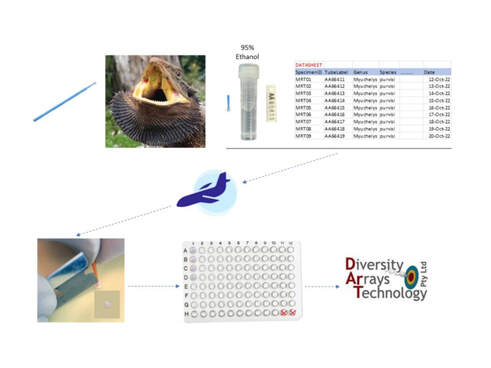
Effective Buccal Swab Sampling for Reptile Genotyping: A Comparison with Traditional Blood Sampling
We wanted to find out if using a simple and non-invasive method, like swabbing the inside of the mouth, could be a good alternative to traditional methods, such as taking blood samples or skin biopsies, for studying reptiles' DNA. We tested this method on two threatened species of turtles, Myuchelys bellii and Myuchelys purvisi, to see if it would work well and give us accurate results.
To do this, we collected DNA from the turtles using both the buccal swab method (swabbing the inside of their mouth) and the traditional blood sampling method. We compared the results from both methods and found that the swabbing method worked just as well, if not better, than the blood sampling. In fact, all the swab samples gave us enough DNA to work with, while one of the blood samples failed.
This means that buccal swabs are a great alternative to other tissue sampling methods, like collecting blood or doing skin biopsies, especially when we want to use a specific type of DNA analysis called DArTSeq genotyping. It's faster and less invasive for the turtles, and it gives us good results.
However, we also need to be careful when using this method. The success of the swabbing depends on following the proper protocols, like making sure to swab the clean surfaces of the inside of the mouth and not relying on saliva alone. This is crucial to get accurate and reliable results. Another thing to keep in mind is that buccal swabs are used up in the process of DNA analysis, so we can't keep them for future use. Unlike blood samples or tissue biopsies, where we can keep some of the sample for later, buccal swabs are used entirely for the testing. To get the best results, we recommend taking multiple swabs from each turtle to make sure we have enough DNA to work with. This will give us more accurate and reliable data. Overall, using buccal swabs for DNA analysis in turtles is a great option. It's non-invasive, easy to do, and gives us good results. However, we need to follow the right procedures and take enough swabs to get the best outcomes. This research is a step forward in finding better and less intrusive ways to study and conserve these threatened turtle species.
Georges, A., Dissanayake, D. S. B., & Spencer, R. J. (2022). Evaluation of the use of buccal swabs as an alternative to blood sampling or skin sampling in freshwater turtles for analysis using DArTSeqTM: Report to the Australian Reptile Park, Somersby.
We wanted to find out if using a simple and non-invasive method, like swabbing the inside of the mouth, could be a good alternative to traditional methods, such as taking blood samples or skin biopsies, for studying reptiles' DNA. We tested this method on two threatened species of turtles, Myuchelys bellii and Myuchelys purvisi, to see if it would work well and give us accurate results.
To do this, we collected DNA from the turtles using both the buccal swab method (swabbing the inside of their mouth) and the traditional blood sampling method. We compared the results from both methods and found that the swabbing method worked just as well, if not better, than the blood sampling. In fact, all the swab samples gave us enough DNA to work with, while one of the blood samples failed.
This means that buccal swabs are a great alternative to other tissue sampling methods, like collecting blood or doing skin biopsies, especially when we want to use a specific type of DNA analysis called DArTSeq genotyping. It's faster and less invasive for the turtles, and it gives us good results.
However, we also need to be careful when using this method. The success of the swabbing depends on following the proper protocols, like making sure to swab the clean surfaces of the inside of the mouth and not relying on saliva alone. This is crucial to get accurate and reliable results. Another thing to keep in mind is that buccal swabs are used up in the process of DNA analysis, so we can't keep them for future use. Unlike blood samples or tissue biopsies, where we can keep some of the sample for later, buccal swabs are used entirely for the testing. To get the best results, we recommend taking multiple swabs from each turtle to make sure we have enough DNA to work with. This will give us more accurate and reliable data. Overall, using buccal swabs for DNA analysis in turtles is a great option. It's non-invasive, easy to do, and gives us good results. However, we need to follow the right procedures and take enough swabs to get the best outcomes. This research is a step forward in finding better and less intrusive ways to study and conserve these threatened turtle species.
Georges, A., Dissanayake, D. S. B., & Spencer, R. J. (2022). Evaluation of the use of buccal swabs as an alternative to blood sampling or skin sampling in freshwater turtles for analysis using DArTSeqTM: Report to the Australian Reptile Park, Somersby.
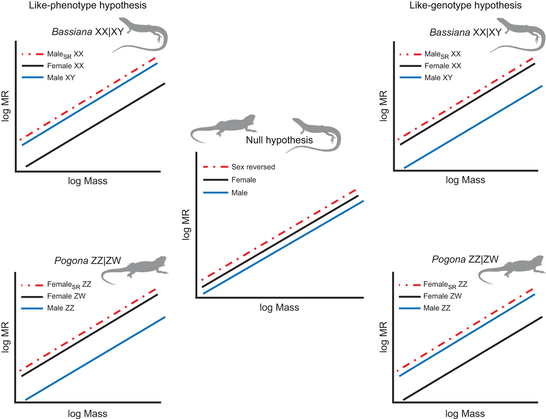
Sex Reversal in Reptiles: Effects on Metabolism and Growth
In many vertebrates, including some reptiles, sex can be determined by genes or temperature during development. This means that an individual's genetic sex (XX or XY) may not always match their physical appearance (male or female). This phenomenon, known as sex reversal, is intriguing and has been observed in different reptile species.
In our study, we investigated the consequences of sex reversal on the traits of offspring in two reptile species: Bassiana duperreyi and Pogona vitticeps. In Bassiana duperreyi, females with XX chromosomes can develop male traits (maleSR XX), while in Pogona vitticeps, males with ZZ chromosomes can develop female traits (femaleSR ZZ).
To understand how sex reversal affects the offspring's traits, we measured two energy-related characteristics: metabolism and growth. We also looked at their survival rate over six months.
In Bassiana duperreyi, we found that males with sex reversal (maleSR XX) had a metabolism similar to regular males (XY), which was lower than their genetic female counterparts (XX). On the other hand, in Pogona vitticeps, females with sex reversal (femaleSR ZZ) had a metabolism that fell in between regular males (ZZ) and regular females (ZW). Interestingly, as individuals grew larger, the differences in metabolism between those with sex reversal and regular individuals became more pronounced. This suggests that the effects of sex reversal on metabolism become more evident as the reptiles mature. Our findings provide some evidence that sex reversal may confer an energetic advantage to the individuals in both species. However, we also acknowledge that there may be other factors at play, and energy-related processes may not fully explain the distribution of sex reversal in nature.
Overall, our study sheds light on the complex interactions between genes, temperature, and traits in reptiles with sex reversal. Understanding these mechanisms can help us better comprehend the evolutionary transitions in sex determination and the implications for the survival and conservation of these fascinating reptile species.
Wild, K. H., Roe, J. H., Rodgers, E. R., Dissanayake, D. S. B., Georges, A., Sare, S. D., & Noble, D. W. A. (2023). Metabolic consequences of sex reversal in two lizard species: A test of the like-genotype and like-phenotype hypotheses. Journal of Experimental Biology, 226(13), jeb245657.
In many vertebrates, including some reptiles, sex can be determined by genes or temperature during development. This means that an individual's genetic sex (XX or XY) may not always match their physical appearance (male or female). This phenomenon, known as sex reversal, is intriguing and has been observed in different reptile species.
In our study, we investigated the consequences of sex reversal on the traits of offspring in two reptile species: Bassiana duperreyi and Pogona vitticeps. In Bassiana duperreyi, females with XX chromosomes can develop male traits (maleSR XX), while in Pogona vitticeps, males with ZZ chromosomes can develop female traits (femaleSR ZZ).
To understand how sex reversal affects the offspring's traits, we measured two energy-related characteristics: metabolism and growth. We also looked at their survival rate over six months.
In Bassiana duperreyi, we found that males with sex reversal (maleSR XX) had a metabolism similar to regular males (XY), which was lower than their genetic female counterparts (XX). On the other hand, in Pogona vitticeps, females with sex reversal (femaleSR ZZ) had a metabolism that fell in between regular males (ZZ) and regular females (ZW). Interestingly, as individuals grew larger, the differences in metabolism between those with sex reversal and regular individuals became more pronounced. This suggests that the effects of sex reversal on metabolism become more evident as the reptiles mature. Our findings provide some evidence that sex reversal may confer an energetic advantage to the individuals in both species. However, we also acknowledge that there may be other factors at play, and energy-related processes may not fully explain the distribution of sex reversal in nature.
Overall, our study sheds light on the complex interactions between genes, temperature, and traits in reptiles with sex reversal. Understanding these mechanisms can help us better comprehend the evolutionary transitions in sex determination and the implications for the survival and conservation of these fascinating reptile species.
Wild, K. H., Roe, J. H., Rodgers, E. R., Dissanayake, D. S. B., Georges, A., Sare, S. D., & Noble, D. W. A. (2023). Metabolic consequences of sex reversal in two lizard species: A test of the like-genotype and like-phenotype hypotheses. Journal of Experimental Biology, 226(13), jeb245657.
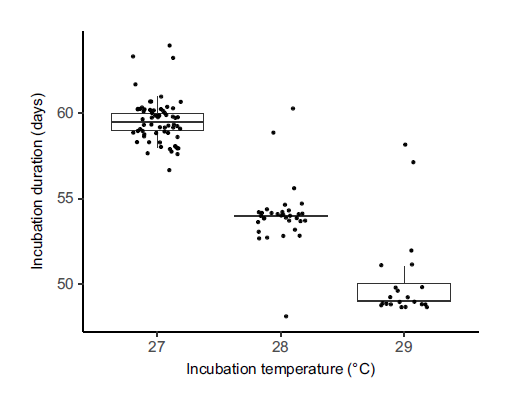
Optimizing Artificial Incubation for Western Saw-Shelled Turtles: Implications for Conservation Efforts
When it comes to conserving endangered turtle species, one common method is to incubate their eggs artificially and release the hatchlings into the wild. In our study, we wanted to figure out the best temperature for hatching success in the western saw-shelled turtle, also known as Myuchelys bellii.
We experimented with different incubation temperatures to find the optimal one for maximum hatching success. We also looked at how the temperature affected the incubation period and hatching success. We tried two different incubation methods at the same temperature of 27°C and found that one resulted in 77% hatching success while the other achieved an impressive 97% success rate.
To understand the influence of temperature on the incubation process, we incubated the eggs at constant temperatures of 27°C, 28°C, and 29°C. What we found was that the higher the temperature, the shorter the incubation period. This means that warmer temperatures make the eggs hatch faster.
We also examined the eggs and hatchlings and noticed some interesting patterns. The size and mass of the eggs and hatchlings were positively related to the size and mass of the adult female turtle. In other words, bigger female turtles produce larger eggs and hatchlings. Among the different constant temperatures we tested, 27°C turned out to be the best. It gave us the highest hatching success rate and the smallest external residual yolk when the hatchlings hatched. The external residual yolk is like a little food reserve for the hatchlings to survive their first few days after hatching. Based on our findings, we recommend using a constant incubation temperature of 27°C for population reinforcement programs. This means that if we want to help increase the number of western saw-shelled turtles in the wild, incubating their eggs at 27°C will give us the best chance of success. Our study is the first one to figure out the best artificial incubation method for M. bellii. It's not just helpful for this specific turtle species but can also be useful for other conservation efforts for threatened freshwater turtles.
By understanding how different temperatures affect the hatching process, we can improve our efforts to protect these amazing creatures and ensure their survival in their natural habitats. Artificial incubation plays a crucial role in boosting their populations and maintaining the delicate balance of our ecosystem.
Streeting, L. M., Bower, D. S., Martin, L., Spark, P., Gough, M., Skidmore, A., McDonald, P. G., Delaney, H., Burns, A., Watson, S., Dissanayake, D. S. B., Georges, A., & McKnight, D. T. (2022). Influence of incubation temperature on incubation duration and hatching success in Bell’s turtle (Myuchelys bellii). Australian Journal of Zoology, 70(2), 74-82.
When it comes to conserving endangered turtle species, one common method is to incubate their eggs artificially and release the hatchlings into the wild. In our study, we wanted to figure out the best temperature for hatching success in the western saw-shelled turtle, also known as Myuchelys bellii.
We experimented with different incubation temperatures to find the optimal one for maximum hatching success. We also looked at how the temperature affected the incubation period and hatching success. We tried two different incubation methods at the same temperature of 27°C and found that one resulted in 77% hatching success while the other achieved an impressive 97% success rate.
To understand the influence of temperature on the incubation process, we incubated the eggs at constant temperatures of 27°C, 28°C, and 29°C. What we found was that the higher the temperature, the shorter the incubation period. This means that warmer temperatures make the eggs hatch faster.
We also examined the eggs and hatchlings and noticed some interesting patterns. The size and mass of the eggs and hatchlings were positively related to the size and mass of the adult female turtle. In other words, bigger female turtles produce larger eggs and hatchlings. Among the different constant temperatures we tested, 27°C turned out to be the best. It gave us the highest hatching success rate and the smallest external residual yolk when the hatchlings hatched. The external residual yolk is like a little food reserve for the hatchlings to survive their first few days after hatching. Based on our findings, we recommend using a constant incubation temperature of 27°C for population reinforcement programs. This means that if we want to help increase the number of western saw-shelled turtles in the wild, incubating their eggs at 27°C will give us the best chance of success. Our study is the first one to figure out the best artificial incubation method for M. bellii. It's not just helpful for this specific turtle species but can also be useful for other conservation efforts for threatened freshwater turtles.
By understanding how different temperatures affect the hatching process, we can improve our efforts to protect these amazing creatures and ensure their survival in their natural habitats. Artificial incubation plays a crucial role in boosting their populations and maintaining the delicate balance of our ecosystem.
Streeting, L. M., Bower, D. S., Martin, L., Spark, P., Gough, M., Skidmore, A., McDonald, P. G., Delaney, H., Burns, A., Watson, S., Dissanayake, D. S. B., Georges, A., & McKnight, D. T. (2022). Influence of incubation temperature on incubation duration and hatching success in Bell’s turtle (Myuchelys bellii). Australian Journal of Zoology, 70(2), 74-82.
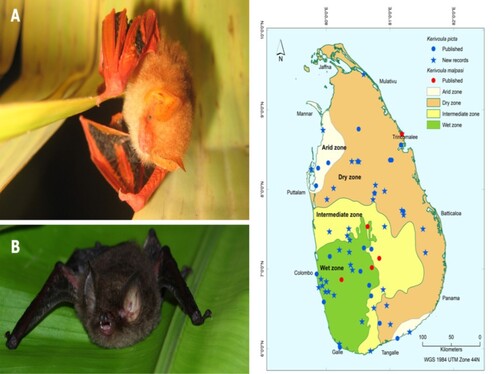
The distribution of Kerivoula malpasi and Kerivoula picta (Chiroptera: Vespertilionidae) in Sri Lanka
Sri Lanka is renowned for being one of the world's biodiversity hotspots, with a rich diversity of bats. Among the bat species found here, Kerivoula malpasi stands out as the only one that is exclusive to Sri Lanka. Interestingly, it has been recorded in only five locations on the island. In contrast, Kerivoula picta, another species of Kerivoula, has a wider distribution across Sri Lanka.
This study aims to map the current and historical distributions of both species. The researchers conducted field observations between 2016 and 2020, leading to the discovery of 41 new locations for K. picta. Among these records, some are the northernmost and easternmost occurrences of the species in Sri Lanka.
To gain a comprehensive understanding, the study also incorporates information from museum specimens of both bat species. By documenting these details, the researchers hope to facilitate future investigations and promote conservation efforts for these unique species in Sri Lanka. Overall, this research sheds light on the distribution patterns of Kerivoula bats in Sri Lanka, providing valuable insights for their conservation and preservation in the country's diverse and ecologically important habitats.
Bandara, M. J., Edirisinghe, G., Patterson, B., Nanayakkara, R., Dissanayake, D., Akmeemana, D., Sumanapala, A., Gabadage, D., & Botejue, M. (2022). The distribution of Kerivoula malpasi and Kerivoula picta (Chiroptera: Vespertilionidae) in Sri Lanka. Journal of Bat Research & Conservation, 15(1), 11-16
Sri Lanka is renowned for being one of the world's biodiversity hotspots, with a rich diversity of bats. Among the bat species found here, Kerivoula malpasi stands out as the only one that is exclusive to Sri Lanka. Interestingly, it has been recorded in only five locations on the island. In contrast, Kerivoula picta, another species of Kerivoula, has a wider distribution across Sri Lanka.
This study aims to map the current and historical distributions of both species. The researchers conducted field observations between 2016 and 2020, leading to the discovery of 41 new locations for K. picta. Among these records, some are the northernmost and easternmost occurrences of the species in Sri Lanka.
To gain a comprehensive understanding, the study also incorporates information from museum specimens of both bat species. By documenting these details, the researchers hope to facilitate future investigations and promote conservation efforts for these unique species in Sri Lanka. Overall, this research sheds light on the distribution patterns of Kerivoula bats in Sri Lanka, providing valuable insights for their conservation and preservation in the country's diverse and ecologically important habitats.
Bandara, M. J., Edirisinghe, G., Patterson, B., Nanayakkara, R., Dissanayake, D., Akmeemana, D., Sumanapala, A., Gabadage, D., & Botejue, M. (2022). The distribution of Kerivoula malpasi and Kerivoula picta (Chiroptera: Vespertilionidae) in Sri Lanka. Journal of Bat Research & Conservation, 15(1), 11-16
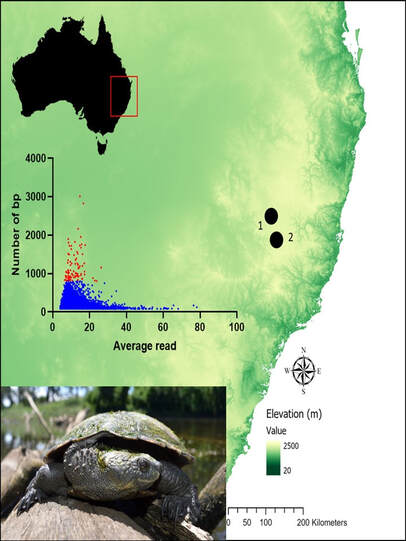
A male-specific sex marker for the endangered western sawshelled turtle (Myuchelys bellii) using insilico whole-genome subtraction
Conservation efforts for endangered turtle species often involve incubating eggs and releasing hatchlings into the wild. But to ensure the right balance of male and female turtles, we need a way to determine their sexes during the early stages of life when we can't see the differences physically. In this study, we developed a special test using the turtles' genetic information to identify their sex even when they are embryos, hatchlings, or small juveniles. We looked at their DNA and found a specific marker that indicates whether a turtle is male or female.
This breakthrough allows conservation programs to release the right mix of male and female turtles into the wild, which is crucial for maintaining healthy populations. Additionally, we can now study the natural sex ratios of these young turtles in the wild without having to wait for them to reach maturity.
Knowing the sex of the turtles will also help us understand how their behavior, movement, and survival may differ between males and females. This knowledge is vital for protecting and preserving these amazing creatures.
Dissanayake, D.S.B., Streeting, L.M., Georges, A. et al. A male-specific sex marker for the endangered western sawshelled turtle (Myuchelys bellii) using in silico whole-genome subtraction. Conservation Genet Resour 14, 231–236 (2022). https://doi.org/10.1007/s12686-022-01266-3
Conservation efforts for endangered turtle species often involve incubating eggs and releasing hatchlings into the wild. But to ensure the right balance of male and female turtles, we need a way to determine their sexes during the early stages of life when we can't see the differences physically. In this study, we developed a special test using the turtles' genetic information to identify their sex even when they are embryos, hatchlings, or small juveniles. We looked at their DNA and found a specific marker that indicates whether a turtle is male or female.
This breakthrough allows conservation programs to release the right mix of male and female turtles into the wild, which is crucial for maintaining healthy populations. Additionally, we can now study the natural sex ratios of these young turtles in the wild without having to wait for them to reach maturity.
Knowing the sex of the turtles will also help us understand how their behavior, movement, and survival may differ between males and females. This knowledge is vital for protecting and preserving these amazing creatures.
Dissanayake, D.S.B., Streeting, L.M., Georges, A. et al. A male-specific sex marker for the endangered western sawshelled turtle (Myuchelys bellii) using in silico whole-genome subtraction. Conservation Genet Resour 14, 231–236 (2022). https://doi.org/10.1007/s12686-022-01266-3
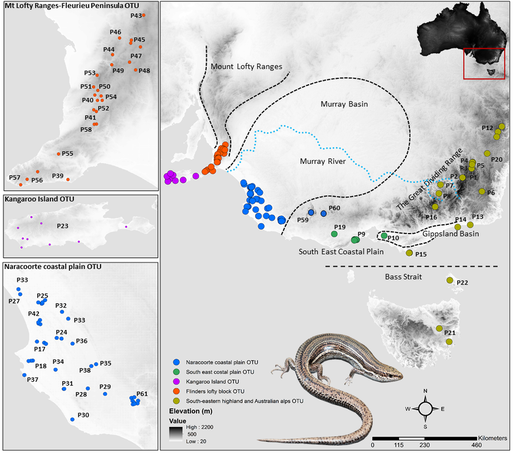
Lineage diversity within a widespread endemic Australian skink to better inform conservation in response to regional‐scale disturbance
In conservation planning, it's important to categorize species based on endangerment criteria and set priorities for action. Traditionally, we focused on species-level classifications. However, now some regions consider lower taxonomic ranks and intraspecific divisions, like subspecies or key populations, for conservation planning.
To understand species boundaries and genetic diversity, researchers studied the Australian eastern three-lined skink, Bassiana duperreyi. They analyzed the DNA of 63 populations covering its distribution, including areas affected by recent bushfires. They found five distinct groups within the skink species.
Interestingly, the genetic differences between skinks in mainland Australia and Tasmania were relatively low, suggesting occasional genetic exchange between these regions during past periods of low sea level. This finding challenges earlier beliefs of long-term isolation. This study provides essential groundwork for reevaluating the taxonomic classification of this skink species complex. It emphasizes the need to consider hidden diversity within species during biodiversity assessments and conservation planning. Such information helps us plan for conservation, even if we don't formally declare new species names.
Dissanayake, D. S., Holleley, C. E., Sumner, J., Melville, J., & Georges, A. (2022). Lineage diversity within a widespread endemic Australian skink to better inform conservation in response to regional‐scale disturbance. Ecology and Evolution, 12(3), e8627.
https://doi.org/10.1002/ece3.8627
In conservation planning, it's important to categorize species based on endangerment criteria and set priorities for action. Traditionally, we focused on species-level classifications. However, now some regions consider lower taxonomic ranks and intraspecific divisions, like subspecies or key populations, for conservation planning.
To understand species boundaries and genetic diversity, researchers studied the Australian eastern three-lined skink, Bassiana duperreyi. They analyzed the DNA of 63 populations covering its distribution, including areas affected by recent bushfires. They found five distinct groups within the skink species.
Interestingly, the genetic differences between skinks in mainland Australia and Tasmania were relatively low, suggesting occasional genetic exchange between these regions during past periods of low sea level. This finding challenges earlier beliefs of long-term isolation. This study provides essential groundwork for reevaluating the taxonomic classification of this skink species complex. It emphasizes the need to consider hidden diversity within species during biodiversity assessments and conservation planning. Such information helps us plan for conservation, even if we don't formally declare new species names.
Dissanayake, D. S., Holleley, C. E., Sumner, J., Melville, J., & Georges, A. (2022). Lineage diversity within a widespread endemic Australian skink to better inform conservation in response to regional‐scale disturbance. Ecology and Evolution, 12(3), e8627.
https://doi.org/10.1002/ece3.8627
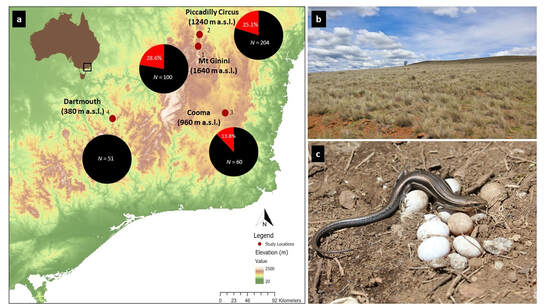
Effects of natural nest temperatures on sex reversal and sex ratios in an Australian alpine skink
Changes in climate can have significant effects on various aspects of organisms, including their physiology, development, behavior, and ecology. These impacts can lead to changes in individual fitness and affect a population's ability to survive in a changing climate. One direct consequence of extreme temperatures is the alteration of the sex ratio within populations, particularly in species whose sex is determined by temperature.
In some species, the sex of individuals is entirely dependent on the temperature during their development (Temperature-Dependent Sex Determination - TSD). Additionally, recent discoveries have shown that extreme environmental temperatures can even cause sex reversal in species with genetic sex determination (GSD). This means that individuals with a specific genetic makeup can develop into the opposite sex under extreme temperature conditions.
In this study, researchers examined the Australian alpine three-lined skink (Bassiana duperreyi), a species with sex chromosomes that also experiences sex reversal at temperatures below 20°C. They found that the rate of sex reversal in this skink species varied with elevation, with higher rates at cooler locations and no sex reversal at warmer locations.
The frequency of sex reversal in these alpine skinks makes them a sensitive indicator of climate change. This sensitivity applies to changes in average temperatures as well as variations in climatic conditions. Monitoring these skinks can help us understand the effects of climate change on wildlife and ecosystems, as shifts in sex ratios can influence population decline and recovery rates.
Dissanayake, D.S.B., Holleley, C.E. & Georges, A. Effects of natural nest temperatures on sex reversal and sex ratios in an Australian alpine skink. Sci Rep 11, 20093 (2021). https://doi.org/10.1038/s41598-021-99702-1
Changes in climate can have significant effects on various aspects of organisms, including their physiology, development, behavior, and ecology. These impacts can lead to changes in individual fitness and affect a population's ability to survive in a changing climate. One direct consequence of extreme temperatures is the alteration of the sex ratio within populations, particularly in species whose sex is determined by temperature.
In some species, the sex of individuals is entirely dependent on the temperature during their development (Temperature-Dependent Sex Determination - TSD). Additionally, recent discoveries have shown that extreme environmental temperatures can even cause sex reversal in species with genetic sex determination (GSD). This means that individuals with a specific genetic makeup can develop into the opposite sex under extreme temperature conditions.
In this study, researchers examined the Australian alpine three-lined skink (Bassiana duperreyi), a species with sex chromosomes that also experiences sex reversal at temperatures below 20°C. They found that the rate of sex reversal in this skink species varied with elevation, with higher rates at cooler locations and no sex reversal at warmer locations.
The frequency of sex reversal in these alpine skinks makes them a sensitive indicator of climate change. This sensitivity applies to changes in average temperatures as well as variations in climatic conditions. Monitoring these skinks can help us understand the effects of climate change on wildlife and ecosystems, as shifts in sex ratios can influence population decline and recovery rates.
Dissanayake, D.S.B., Holleley, C.E. & Georges, A. Effects of natural nest temperatures on sex reversal and sex ratios in an Australian alpine skink. Sci Rep 11, 20093 (2021). https://doi.org/10.1038/s41598-021-99702-1
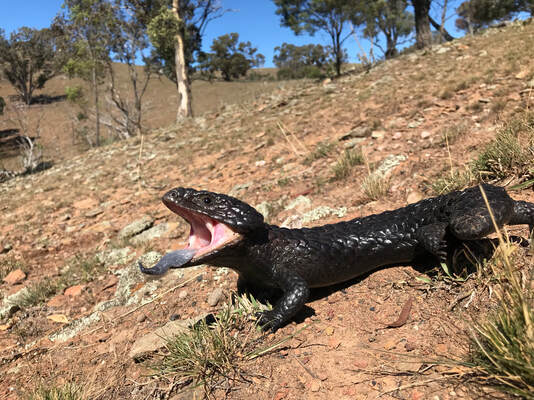
Australian lizards are outstanding models for reproductive biology research
Our newest paper on Australian lizards are outstanding models for reproductive biology research is now published online in the Australian Journal of Zoology. Twenty-six Australian researchers contributed to this review article, and it was just amazing to work with them.
Australian lizards are a diverse and fascinating group of reptiles found throughout the continent, living in various environments. They display a wide range of reproductive characteristics, behaviors, and strategies, which make them an excellent model for studying reproductive traits in vertebrates. Many of these traits, such as social behaviors, complex signaling, viviparity (giving birth to live young), and temperature-dependent sex determination, have independently evolved in different lizard lineages.
Researchers have found that studying the reproductive aspects of Australian lizards has provided valuable insights into broader questions about evolution and ecology in the animal kingdom. By focusing on courtship behaviors, mating mechanisms, egg production, sperm competition, nesting, gestation, sex determination, and birth in viviparous species, scientists have gained a deeper understanding of how these processes function and evolve.
The knowledge gained from studying Australian lizards' reproduction serves as a basis for comparison with other animals that exhibit similar traits. It allows researchers to explore questions about reproductive strategies that apply to a wide range of animals beyond just lizards. The review of research on Australian lizard reproduction has helped identify important areas of current investigation, shedding light on various aspects of these creatures' lives. Moreover, it has revealed intriguing questions that warrant further exploration in the field of reproductive biology.In conclusion, Australian lizards have become invaluable subjects for scientists studying reproductive traits and behaviors. Their unique diversity and evolutionary history offer a wealth of opportunities to uncover fundamental insights into the reproductive strategies of various animal species.
Van Dyke, J.U., Thompson, M.B., Burridge, C.P., Castelli, M.A., Clulow, S., Dissanayake, D.S., Dong, C.M., Doody, J.S., Edwards, D.L., Ezaz, T. and Friesen, C.R., 2021. Australian lizards are outstanding models for reproductive biology research. Australian Journal of Zoology.
Our newest paper on Australian lizards are outstanding models for reproductive biology research is now published online in the Australian Journal of Zoology. Twenty-six Australian researchers contributed to this review article, and it was just amazing to work with them.
Australian lizards are a diverse and fascinating group of reptiles found throughout the continent, living in various environments. They display a wide range of reproductive characteristics, behaviors, and strategies, which make them an excellent model for studying reproductive traits in vertebrates. Many of these traits, such as social behaviors, complex signaling, viviparity (giving birth to live young), and temperature-dependent sex determination, have independently evolved in different lizard lineages.
Researchers have found that studying the reproductive aspects of Australian lizards has provided valuable insights into broader questions about evolution and ecology in the animal kingdom. By focusing on courtship behaviors, mating mechanisms, egg production, sperm competition, nesting, gestation, sex determination, and birth in viviparous species, scientists have gained a deeper understanding of how these processes function and evolve.
The knowledge gained from studying Australian lizards' reproduction serves as a basis for comparison with other animals that exhibit similar traits. It allows researchers to explore questions about reproductive strategies that apply to a wide range of animals beyond just lizards. The review of research on Australian lizard reproduction has helped identify important areas of current investigation, shedding light on various aspects of these creatures' lives. Moreover, it has revealed intriguing questions that warrant further exploration in the field of reproductive biology.In conclusion, Australian lizards have become invaluable subjects for scientists studying reproductive traits and behaviors. Their unique diversity and evolutionary history offer a wealth of opportunities to uncover fundamental insights into the reproductive strategies of various animal species.
Van Dyke, J.U., Thompson, M.B., Burridge, C.P., Castelli, M.A., Clulow, S., Dissanayake, D.S., Dong, C.M., Doody, J.S., Edwards, D.L., Ezaz, T. and Friesen, C.R., 2021. Australian lizards are outstanding models for reproductive biology research. Australian Journal of Zoology.
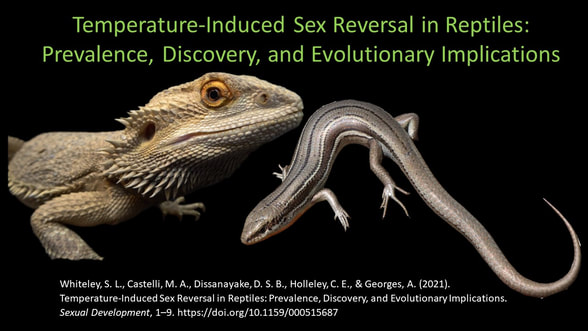
Our review article on Temperature-Induced Sex Reversal in Reptiles: Prevalence, Discovery, and Evolutionary Implications came out today in Sexual Development.
Sex reversal is a fascinating phenomenon where an individual develops a physical sex that doesn't match its genetic sex. This occurs in various cold-blooded vertebrates like fish, amphibians, and certain reptiles like agamids and scincids. Usually, an environmental cue triggers this process, altering the natural sexual development determined by genes. It can also be caused by exposure to external substances like chemicals, hormones, or pollutants.
Among reptiles, there are two main methods of determining sex: temperature-dependent sex determination (TSD) and genetic sex determination (GSD). While TSD and GSD are widespread, only two species of squamates (a group of reptiles) have been found to undergo natural sex reversal (GSD influenced by temperature).
The scarcity of well-documented instances of sex reversal in reptiles doesn't necessarily mean it's rare. It might be more common, but we still have much to learn about its prevalence, mechanisms, and impacts on wild populations, especially with our changing climate.
In this review, the authors present a roadmap for discovering sex reversal in reptiles. They outline techniques to identify new cases of sex reversal, explore the molecular mechanisms behind it, and suggest ways to assess its effects on wild populations. They discuss the evolutionary implications and use the central bearded dragon and the eastern three-lined skink as examples to show how species with different patterns of sex reversal may be affected differently by climate change. Ultimately, this review emphasizes the importance of understanding sex reversal, both in laboratory settings and wild environments, and proposes practical solutions for future research in this fascinating area of science.
Whiteley, S. L., Castelli, M. A., Dissanayake, D. S. B., Holleley, C., & Georges, A. (2021). Temperature-induced sex reversal provides new insights into the evolution of sex determination. Sexual Development, 15, 148–156.
Sex reversal is a fascinating phenomenon where an individual develops a physical sex that doesn't match its genetic sex. This occurs in various cold-blooded vertebrates like fish, amphibians, and certain reptiles like agamids and scincids. Usually, an environmental cue triggers this process, altering the natural sexual development determined by genes. It can also be caused by exposure to external substances like chemicals, hormones, or pollutants.
Among reptiles, there are two main methods of determining sex: temperature-dependent sex determination (TSD) and genetic sex determination (GSD). While TSD and GSD are widespread, only two species of squamates (a group of reptiles) have been found to undergo natural sex reversal (GSD influenced by temperature).
The scarcity of well-documented instances of sex reversal in reptiles doesn't necessarily mean it's rare. It might be more common, but we still have much to learn about its prevalence, mechanisms, and impacts on wild populations, especially with our changing climate.
In this review, the authors present a roadmap for discovering sex reversal in reptiles. They outline techniques to identify new cases of sex reversal, explore the molecular mechanisms behind it, and suggest ways to assess its effects on wild populations. They discuss the evolutionary implications and use the central bearded dragon and the eastern three-lined skink as examples to show how species with different patterns of sex reversal may be affected differently by climate change. Ultimately, this review emphasizes the importance of understanding sex reversal, both in laboratory settings and wild environments, and proposes practical solutions for future research in this fascinating area of science.
Whiteley, S. L., Castelli, M. A., Dissanayake, D. S. B., Holleley, C., & Georges, A. (2021). Temperature-induced sex reversal provides new insights into the evolution of sex determination. Sexual Development, 15, 148–156.
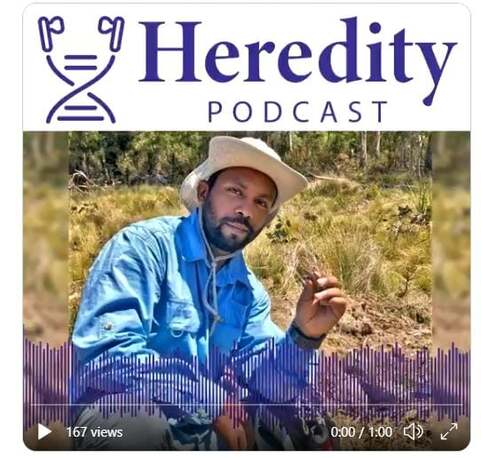
We have been a featured guest on the nature heredity podcast on our recent work on lizard sex reversal in the Australian high country.
You can hear the podcast here:
https://play.acast.com/s/heredity-podcast-naturecom-science-feeds/reversingsex
or read more about the project here
http://georges.biomatix.org/blog/post/lizard-sex-reversal
or go to the original article
https://doi.org/10.1038/s41437-021-00406-z
Abstract
The view that has genotypic sex determination and environmental sex determination as mutually exclusive states in fishes and reptiles has been contradicted by the discovery that chromosomal sex and environmental influences can co-exist within the same species, hinting at a continuum of intermediate states. Systems where genes and the environment interact to determine sex present the opportunity for sex reversal to occur, where the phenotypic sex is the opposite of that predicted by their sex chromosome complement. The skink Bassiana duperreyi has XX/XY sex chromosomes with sex reversal of the XX genotype to a male phenotype, in laboratory experiments, and in field nests, in response to exposure to cold incubation temperatures. Here we studied the frequency of sex reversal in adult populations of B. duperreyi in response to climatic variation, using elevation as a surrogate for environmental temperatures. We demonstrate sex reversal in the wild for the first time in adults of a reptile species with XX/XY sex determination. The highest frequency of sex reversal occurred at the highest coolest elevation location, Mt Ginini (18.46%) and decreased in frequency to zero with decreasing elevation. We model the impact of this under Fisher’s frequency-dependent selection to show that, at the highest elevations, populations risk the loss of the Y chromosome and a transition to temperature-dependent sex determination. This study contributes to our understanding of the risks of extinction from climate change in species subject to sex reversal by temperature, and will provide focus for future research to test on-the-ground management strategies to mitigate the effects of climate in local populations.
You can hear the podcast here:
https://play.acast.com/s/heredity-podcast-naturecom-science-feeds/reversingsex
or read more about the project here
http://georges.biomatix.org/blog/post/lizard-sex-reversal
or go to the original article
https://doi.org/10.1038/s41437-021-00406-z
Abstract
The view that has genotypic sex determination and environmental sex determination as mutually exclusive states in fishes and reptiles has been contradicted by the discovery that chromosomal sex and environmental influences can co-exist within the same species, hinting at a continuum of intermediate states. Systems where genes and the environment interact to determine sex present the opportunity for sex reversal to occur, where the phenotypic sex is the opposite of that predicted by their sex chromosome complement. The skink Bassiana duperreyi has XX/XY sex chromosomes with sex reversal of the XX genotype to a male phenotype, in laboratory experiments, and in field nests, in response to exposure to cold incubation temperatures. Here we studied the frequency of sex reversal in adult populations of B. duperreyi in response to climatic variation, using elevation as a surrogate for environmental temperatures. We demonstrate sex reversal in the wild for the first time in adults of a reptile species with XX/XY sex determination. The highest frequency of sex reversal occurred at the highest coolest elevation location, Mt Ginini (18.46%) and decreased in frequency to zero with decreasing elevation. We model the impact of this under Fisher’s frequency-dependent selection to show that, at the highest elevations, populations risk the loss of the Y chromosome and a transition to temperature-dependent sex determination. This study contributes to our understanding of the risks of extinction from climate change in species subject to sex reversal by temperature, and will provide focus for future research to test on-the-ground management strategies to mitigate the effects of climate in local populations.

MY PHD THESIS HAS BEEN SUBMITTED - 16/07/2021
I've just submitted my Ph.D. thesis for examination. What an amazing journey the last 4 years have been! Thesis scientific contributions: 69501words, 256pages, 4 published manuscripts, 2 in review, 1 to be submitted, and 2 data sets sitting on my desk to complete.Thank you so much to all my supervisors, collaborators, funding bodies & friends! Just hope my examiners like my work!
I've just submitted my Ph.D. thesis for examination. What an amazing journey the last 4 years have been! Thesis scientific contributions: 69501words, 256pages, 4 published manuscripts, 2 in review, 1 to be submitted, and 2 data sets sitting on my desk to complete.Thank you so much to all my supervisors, collaborators, funding bodies & friends! Just hope my examiners like my work!

Changing Climates Impacting Lizard Populations: Surprising Discoveries on Sex Reversal
We are excited to share our latest research published in the journal Heredity, where we explored the fascinating world of Bassiana duperreyi, a skink species found in the Australian Alps. Our study delved into how these lizards deal with varying environmental conditions and how it affects their biological sex.
You see, in the animal kingdom, there are two main ways individuals determine their sex. The first is through their genes (genetic sex determination), and the second is based on environmental factors like temperature (environmental sex determination). For a long time, scientists believed these two methods were mutually exclusive, but we found something intriguing - they can actually coexist in some species, suggesting a continuum of possibilities in between.
Our focus was on sex reversal, a fascinating phenomenon where individuals develop a different physical sex than what their genes suggest. Imagine a lizard with XX chromosomes (typically female) developing into a male or a lizard with XY chromosomes (typically male) becoming female! This unique trait offers a chance to study how genes and the environment interact to determine sex.
In our laboratory experiments and field observations, we discovered that Bassiana duperreyi can undergo sex reversal in response to exposure to cold temperatures. This means that some lizards with XX chromosomes turned into males under certain conditions. It was truly astonishing to find this happening in wild adult reptiles with XX/XY sex chromosomes!To understand this process better, we studied populations of B. duperreyi along an elevational gradient in the Australian Alps. We used elevation as a proxy for temperature, as higher altitudes tend to be colder. What we found was even more intriguing. At the highest, coolest location (Mt Ginini), we observed the highest frequency of sex reversal (18.46%), and as we moved to lower elevations, the frequency decreased until we found no sex reversal at all on the coast of Victoria.
This gradient of sex reversal brought up some interesting questions about the consequences of this process. We used mathematical models to explore how this could impact the lizards' populations over time. The results showed that at the highest elevations, populations are at risk of losing their Y chromosome, which could eventually lead to a switch from genetic sex determination to relying on temperature to determine sex (TSD). The implications of these findings are significant, especially with climate change affecting environments worldwide. As temperatures continue to rise, species like B. duperreyi that rely on temperature-driven sex determination might face challenges. The loss of genetic diversity due to sex reversal could increase their vulnerability to extinction.
Understanding these risks is crucial for conservation efforts. Our study sheds light on how sex reversal can influence lizard populations in a changing climate. It also calls for further research to develop strategies for managing and protecting these unique reptiles. We are hopeful that our work will contribute to a better understanding of the complex relationship between genes, environment, and sex determination in reptiles and provide a solid foundation for conserving these amazing creatures in the face of environmental challenges.
Dissanayake, D.S.B., Holleley, C.E., Deakin, J.E., Georges, A. High elevation increases the risk of Y chromosome loss in Alpine skink populations with sex reversal. Heredity (2021).
We are excited to share our latest research published in the journal Heredity, where we explored the fascinating world of Bassiana duperreyi, a skink species found in the Australian Alps. Our study delved into how these lizards deal with varying environmental conditions and how it affects their biological sex.
You see, in the animal kingdom, there are two main ways individuals determine their sex. The first is through their genes (genetic sex determination), and the second is based on environmental factors like temperature (environmental sex determination). For a long time, scientists believed these two methods were mutually exclusive, but we found something intriguing - they can actually coexist in some species, suggesting a continuum of possibilities in between.
Our focus was on sex reversal, a fascinating phenomenon where individuals develop a different physical sex than what their genes suggest. Imagine a lizard with XX chromosomes (typically female) developing into a male or a lizard with XY chromosomes (typically male) becoming female! This unique trait offers a chance to study how genes and the environment interact to determine sex.
In our laboratory experiments and field observations, we discovered that Bassiana duperreyi can undergo sex reversal in response to exposure to cold temperatures. This means that some lizards with XX chromosomes turned into males under certain conditions. It was truly astonishing to find this happening in wild adult reptiles with XX/XY sex chromosomes!To understand this process better, we studied populations of B. duperreyi along an elevational gradient in the Australian Alps. We used elevation as a proxy for temperature, as higher altitudes tend to be colder. What we found was even more intriguing. At the highest, coolest location (Mt Ginini), we observed the highest frequency of sex reversal (18.46%), and as we moved to lower elevations, the frequency decreased until we found no sex reversal at all on the coast of Victoria.
This gradient of sex reversal brought up some interesting questions about the consequences of this process. We used mathematical models to explore how this could impact the lizards' populations over time. The results showed that at the highest elevations, populations are at risk of losing their Y chromosome, which could eventually lead to a switch from genetic sex determination to relying on temperature to determine sex (TSD). The implications of these findings are significant, especially with climate change affecting environments worldwide. As temperatures continue to rise, species like B. duperreyi that rely on temperature-driven sex determination might face challenges. The loss of genetic diversity due to sex reversal could increase their vulnerability to extinction.
Understanding these risks is crucial for conservation efforts. Our study sheds light on how sex reversal can influence lizard populations in a changing climate. It also calls for further research to develop strategies for managing and protecting these unique reptiles. We are hopeful that our work will contribute to a better understanding of the complex relationship between genes, environment, and sex determination in reptiles and provide a solid foundation for conserving these amazing creatures in the face of environmental challenges.
Dissanayake, D.S.B., Holleley, C.E., Deakin, J.E., Georges, A. High elevation increases the risk of Y chromosome loss in Alpine skink populations with sex reversal. Heredity (2021).
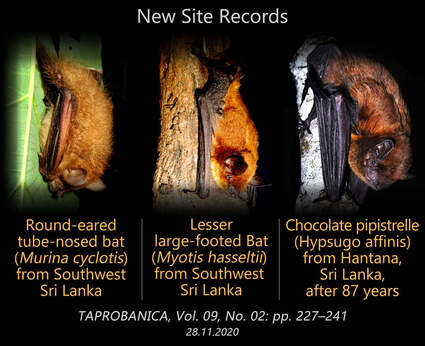
New Site Records
New site records published today in Taprobanica, The Journal of Asian Biodiversity
Round-eared tube-nosed bat (Murina cyclotis) from Southwest Sri Lanka.
http://file.taprobanica.org/238_murina_cyclotis...
Lesser large-footed Bat (Myotis hasseltii) from Southwest Sri Lanka.
http://file.taprobanica.org/239_myotis_hasseltii...
Chocolate pipistrelle (Hypsugo affinis) from Hantana, Sri Lanka, after 87 years.
http://file.taprobanica.org/240_hypsugo_affinis...
Published on 28 November 2020 in Taprobanica, The Journal of Asian Biodiversity
Authors: Gayan Mithra Edirisinghe , Dinesh Eransake Gabadage, Madhava Botejue, Thilina Surasinghe, Prasanna Chandika, Duminda Dissanayake, Sameera Akmeemana & S. Yaddehige
New site records published today in Taprobanica, The Journal of Asian Biodiversity
Round-eared tube-nosed bat (Murina cyclotis) from Southwest Sri Lanka.
http://file.taprobanica.org/238_murina_cyclotis...
Lesser large-footed Bat (Myotis hasseltii) from Southwest Sri Lanka.
http://file.taprobanica.org/239_myotis_hasseltii...
Chocolate pipistrelle (Hypsugo affinis) from Hantana, Sri Lanka, after 87 years.
http://file.taprobanica.org/240_hypsugo_affinis...
Published on 28 November 2020 in Taprobanica, The Journal of Asian Biodiversity
Authors: Gayan Mithra Edirisinghe , Dinesh Eransake Gabadage, Madhava Botejue, Thilina Surasinghe, Prasanna Chandika, Duminda Dissanayake, Sameera Akmeemana & S. Yaddehige
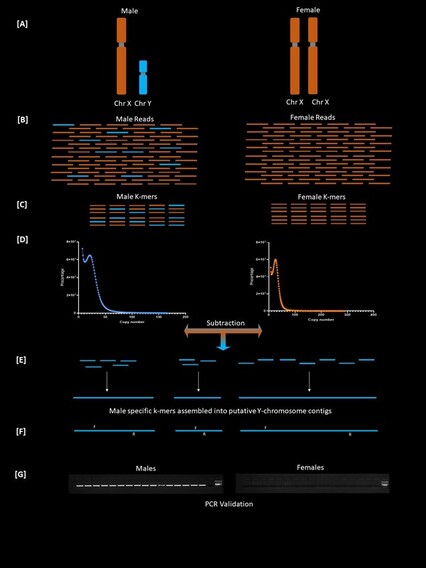
In Silico Isolation of Sex-Specific Markers: A Breakthrough in Reptile Sex Chromosome Research
We are thrilled to announce our latest research published in BMC Genomics. With advancements in next-generation sequencing, we have developed innovative methods to screen sex-linked DNA and identify sex-specific markers in non-classical model organisms.
In this study, we applied a cutting-edge in silico approach, similar to genomic representational difference analysis, to isolate sex-specific markers based on unique sequences from the Y or W chromosome. This is the first time such a technique has been used in a reptile, specifically the Bassiana duperreyi lizard.
By utilizing low-depth whole-genome sequencing of a male and a female B. duperreyi, we identified 7 reliable markers that were validated as Y chromosome-specific using polymerase chain reaction (PCR). These markers will be invaluable for ongoing studies of this lizard species, both in laboratory settings and in the wild. In organisms with heteromorphic sex chromosomes (XY or WZ), recombination is suppressed in the sex-determining region, leading to sequence divergence between the X (or Z) and Y (or W) chromosomes. This divergence allows us to identify Y-specific sequences, which are essential for developing sex-linked markers.
The significance of this research extends beyond B. duperreyi. Our in silico whole-genome subtraction pipeline can be applied to any organism to isolate Y or W chromosome-specific sequences, even beyond single-copy genes. This breakthrough has the potential to revolutionize our understanding of sex determination and sex chromosome evolution in various species. For B. duperreyi, understanding sex-specific markers is particularly crucial as the sex of these lizards can be influenced by temperature. Under low temperatures, individuals with XX genotypes can reverse to a male phenotype. The developed markers will help identify the underlying genetic sex and its agreement or disagreement with the observed physical sex in wild populations.
By improving our knowledge of the Y chromosome in B. duperreyi, our study lays the foundation for future research in reptile sex determination and sex chromosome evolution. This exciting development promises to be a valuable tool for studying sex-linked traits and enhancing conservation efforts for various reptile species.
Dissanayake, D.S.B., Holleley, C.E., Hill, L.K. et al. Identification of Y chromosome markers in the eastern three-lined skink (Bassiana duperreyi) using in silico whole genome subtraction. BMC Genomics 21, 667 (2020).
https://bmcgenomics.biomedcentral.com/.../s12864-020-07071-2
We are thrilled to announce our latest research published in BMC Genomics. With advancements in next-generation sequencing, we have developed innovative methods to screen sex-linked DNA and identify sex-specific markers in non-classical model organisms.
In this study, we applied a cutting-edge in silico approach, similar to genomic representational difference analysis, to isolate sex-specific markers based on unique sequences from the Y or W chromosome. This is the first time such a technique has been used in a reptile, specifically the Bassiana duperreyi lizard.
By utilizing low-depth whole-genome sequencing of a male and a female B. duperreyi, we identified 7 reliable markers that were validated as Y chromosome-specific using polymerase chain reaction (PCR). These markers will be invaluable for ongoing studies of this lizard species, both in laboratory settings and in the wild. In organisms with heteromorphic sex chromosomes (XY or WZ), recombination is suppressed in the sex-determining region, leading to sequence divergence between the X (or Z) and Y (or W) chromosomes. This divergence allows us to identify Y-specific sequences, which are essential for developing sex-linked markers.
The significance of this research extends beyond B. duperreyi. Our in silico whole-genome subtraction pipeline can be applied to any organism to isolate Y or W chromosome-specific sequences, even beyond single-copy genes. This breakthrough has the potential to revolutionize our understanding of sex determination and sex chromosome evolution in various species. For B. duperreyi, understanding sex-specific markers is particularly crucial as the sex of these lizards can be influenced by temperature. Under low temperatures, individuals with XX genotypes can reverse to a male phenotype. The developed markers will help identify the underlying genetic sex and its agreement or disagreement with the observed physical sex in wild populations.
By improving our knowledge of the Y chromosome in B. duperreyi, our study lays the foundation for future research in reptile sex determination and sex chromosome evolution. This exciting development promises to be a valuable tool for studying sex-linked traits and enhancing conservation efforts for various reptile species.
Dissanayake, D.S.B., Holleley, C.E., Hill, L.K. et al. Identification of Y chromosome markers in the eastern three-lined skink (Bassiana duperreyi) using in silico whole genome subtraction. BMC Genomics 21, 667 (2020).
https://bmcgenomics.biomedcentral.com/.../s12864-020-07071-2
|
Great to see the Centre for Conservation Ecology and Genetics at U Canberra on Twitter! Just follow us if you want to see some of the astonishing research in conservation, ecology, and genetics/genomics!
https://twitter.com/UC_CCEG/status/1369452767576788999?s=20 Photo credit: @UniCanberra #UniCBR Institute for Applied Ecology, University of Canberra |
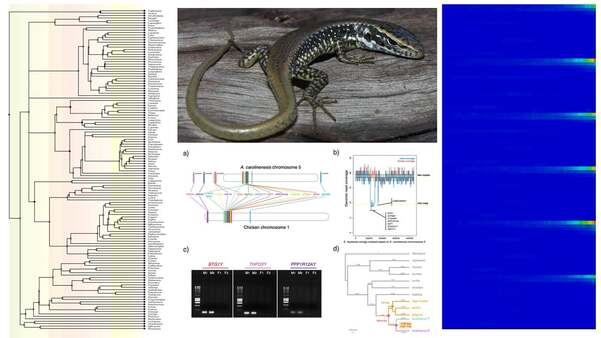
Discovering Sex Chromosomes in the Yellow-Bellied Water Skink: Insights into Reptile Sex Determination and Viviparity
We are excited to share our recent paper, published in Genome Biology and Evolution, which sheds light on the sex determination system in the Yellow-Bellied Water Skink (Eulamprus heatwolei) found in Australia. This species was previously known for its viviparity (giving birth to live young) with temperature-dependent sex determination, creating quite a buzz in the scientific community.
In our research, we made a groundbreaking discovery - the presence of XY chromosomes in E. heatwolei. This means that, like humans, this skink species has sex chromosomes that determine whether individuals are male (XY) or female (XX). We also found that the Y chromosomal region, responsible for determining maleness, is ancient, dating back 79 to 116 million years, and is shared with another skink species, the Spotted Skinks (Niveoscincus ocellatus). This finding provides strong evidence that climate, particularly temperature, can be a useful predictor of the type of sex determination systems in reptiles. It is intriguing to note that despite E. heatwolei and Eulamprus tympanum having thermally induced sex determination and reproducing in relatively cold temperatures (12–15 °C), they still possess sex chromosomes. This sets them apart from most reptiles that rely solely on temperature cues for sex determination.
Moreover, our discovery highlights the intriguing link between viviparity and sex chromosomes. While viviparous reptiles with temperature-dependent sex determination are rare, E. heatwolei's possession of XY chromosomes indicates a close association between viviparity and sex chromosomes. To arrive at these findings, we generated transcriptome and genome data for E. heatwolei. We identified 14 gametologs (genes involved in reproduction) with regulatory functions on the Y chromosome.
Our research not only advances our understanding of reptile sex determination but also highlights the importance of considering sex chromosomes in the context of viviparity. This knowledge will be valuable for future studies on reptile evolution, and it may even help predict sex determination systems in other reptile species based on their environmental conditions. Overall, our study offers exciting insights into the complex world of reptile sex determination and opens up new avenues for investigating the interplay between genetics, climate, and reproduction in these fascinating species.
Paola Cornejo-Páramo, Duminda S B Dissanayake, Andrés Lira-Noriega, Mónica L Martínez-Pacheco, Armando Acosta, Ciro Ramírez-Suástegui, Fausto R Méndez-de-la-Cruz, Tamás Székely, Araxi O Urrutia, Arthur Georges, Diego Cortez, Viviparous Reptile Regarded to Have Temperature-Dependent Sex Determination Has Old XY Chromosomes, Genome Biology and Evolution, Volume 12, Issue 6, June 2020, Pages 924–930, https://doi.org/10.1093/gbe/evaa104
We are excited to share our recent paper, published in Genome Biology and Evolution, which sheds light on the sex determination system in the Yellow-Bellied Water Skink (Eulamprus heatwolei) found in Australia. This species was previously known for its viviparity (giving birth to live young) with temperature-dependent sex determination, creating quite a buzz in the scientific community.
In our research, we made a groundbreaking discovery - the presence of XY chromosomes in E. heatwolei. This means that, like humans, this skink species has sex chromosomes that determine whether individuals are male (XY) or female (XX). We also found that the Y chromosomal region, responsible for determining maleness, is ancient, dating back 79 to 116 million years, and is shared with another skink species, the Spotted Skinks (Niveoscincus ocellatus). This finding provides strong evidence that climate, particularly temperature, can be a useful predictor of the type of sex determination systems in reptiles. It is intriguing to note that despite E. heatwolei and Eulamprus tympanum having thermally induced sex determination and reproducing in relatively cold temperatures (12–15 °C), they still possess sex chromosomes. This sets them apart from most reptiles that rely solely on temperature cues for sex determination.
Moreover, our discovery highlights the intriguing link between viviparity and sex chromosomes. While viviparous reptiles with temperature-dependent sex determination are rare, E. heatwolei's possession of XY chromosomes indicates a close association between viviparity and sex chromosomes. To arrive at these findings, we generated transcriptome and genome data for E. heatwolei. We identified 14 gametologs (genes involved in reproduction) with regulatory functions on the Y chromosome.
Our research not only advances our understanding of reptile sex determination but also highlights the importance of considering sex chromosomes in the context of viviparity. This knowledge will be valuable for future studies on reptile evolution, and it may even help predict sex determination systems in other reptile species based on their environmental conditions. Overall, our study offers exciting insights into the complex world of reptile sex determination and opens up new avenues for investigating the interplay between genetics, climate, and reproduction in these fascinating species.
Paola Cornejo-Páramo, Duminda S B Dissanayake, Andrés Lira-Noriega, Mónica L Martínez-Pacheco, Armando Acosta, Ciro Ramírez-Suástegui, Fausto R Méndez-de-la-Cruz, Tamás Székely, Araxi O Urrutia, Arthur Georges, Diego Cortez, Viviparous Reptile Regarded to Have Temperature-Dependent Sex Determination Has Old XY Chromosomes, Genome Biology and Evolution, Volume 12, Issue 6, June 2020, Pages 924–930, https://doi.org/10.1093/gbe/evaa104
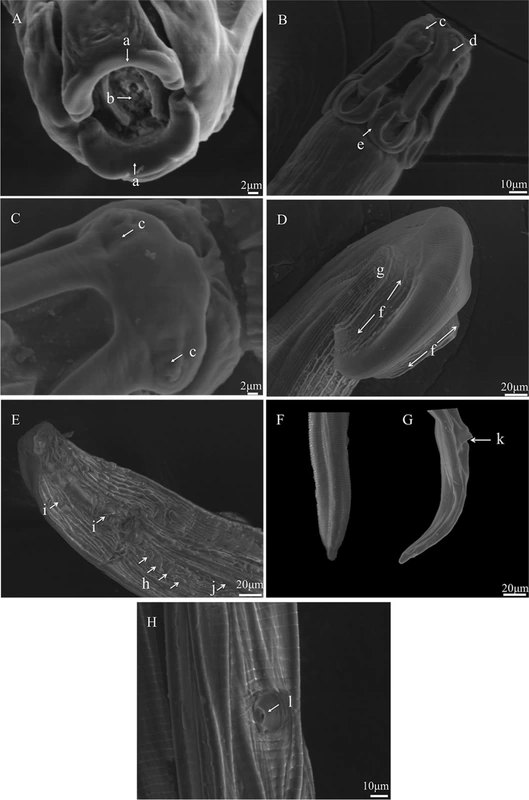
Unveiling the Hidden World of Parasites in Wild Elephants: A Tale of Parabronema smithii
We embarked on an exciting journey to explore the hidden world of parasites in wild elephants living in Sri Lanka. Our main focus was on a particular parasite called Parabronema smithii, which can be found in the stomach ulcers of these majestic creatures.
To understand this parasite better, we carefully examined its physical characteristics using different types of microscopes. This allowed us to see the parasite up close and understand its unique features. We compared it to other similar parasites found in different hosts to learn more about its relationship with them.
But that's not all! We didn't stop there. To delve even deeper into the mystery of this parasite, we conducted a special kind of genetic analysis. By studying specific parts of its DNA, we were able to determine its evolutionary history and how it is related to other parasites.
What we discovered was truly fascinating. Parabronema smithii is closely connected to other species like P. skrjabini and Habronema spp., which are also parasites. This finding not only helps us understand the biology and taxonomy of P. smithii in elephants but also adds valuable information to the field of phylogeography (studying the historical movements of species).
Our research opens up new avenues of exploration into the world of parasites in wild elephants. By understanding these tiny creatures better, we can develop better strategies to protect these gentle giants from any harm they might face from these parasites. It's a step towards ensuring a healthier and safer future for these amazing animals in their natural habitat.
Thewarage, L. D., Dissanayake, D. S. B., Perera, K. V. U. S., Bandara, K. B. A. T., Perera, V. P., Wickramasinghe, S., & Rajapakse, R. P. V. J. (2020). Morphology and molecular characterization of Parabronema smithii (Cobbold, 1882) (Nematoda: Habronematidae) from wild Asian elephant (Elephas maximus maximus) of Sri Lanka. Acta Parasitologica, 65(2), 504-517.
We embarked on an exciting journey to explore the hidden world of parasites in wild elephants living in Sri Lanka. Our main focus was on a particular parasite called Parabronema smithii, which can be found in the stomach ulcers of these majestic creatures.
To understand this parasite better, we carefully examined its physical characteristics using different types of microscopes. This allowed us to see the parasite up close and understand its unique features. We compared it to other similar parasites found in different hosts to learn more about its relationship with them.
But that's not all! We didn't stop there. To delve even deeper into the mystery of this parasite, we conducted a special kind of genetic analysis. By studying specific parts of its DNA, we were able to determine its evolutionary history and how it is related to other parasites.
What we discovered was truly fascinating. Parabronema smithii is closely connected to other species like P. skrjabini and Habronema spp., which are also parasites. This finding not only helps us understand the biology and taxonomy of P. smithii in elephants but also adds valuable information to the field of phylogeography (studying the historical movements of species).
Our research opens up new avenues of exploration into the world of parasites in wild elephants. By understanding these tiny creatures better, we can develop better strategies to protect these gentle giants from any harm they might face from these parasites. It's a step towards ensuring a healthier and safer future for these amazing animals in their natural habitat.
Thewarage, L. D., Dissanayake, D. S. B., Perera, K. V. U. S., Bandara, K. B. A. T., Perera, V. P., Wickramasinghe, S., & Rajapakse, R. P. V. J. (2020). Morphology and molecular characterization of Parabronema smithii (Cobbold, 1882) (Nematoda: Habronematidae) from wild Asian elephant (Elephas maximus maximus) of Sri Lanka. Acta Parasitologica, 65(2), 504-517.
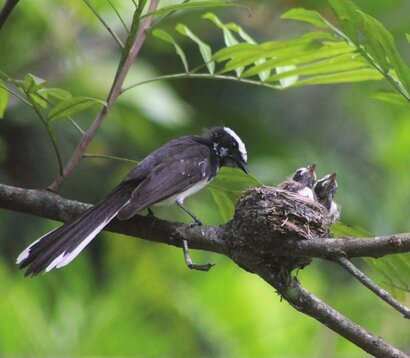
The Fascinating World of the White-browed Fantail Flycatcher: Nesting Insights from Sri Lanka
In the tropical regions of the Indian subcontinent and Southeast Asia, there is a beautiful and widely distributed bird called the White-browed Fantail Flycatcher. We were curious to learn more about these birds, especially their breeding habits and where they build their nests.
For five years, from 2012 to 2017, we closely observed these birds in Sri Lanka. We discovered that their nests were small cup-shaped structures without any "tail" extending below the base. Both male and female fantails were involved in building these nests, and they completed the construction within 9 to 13 days. The nests had an average size of about 6.4 cm in external diameter, 5.6 cm in internal diameter, and 2.9 cm in depth. The birds were quite adaptable and chose various habitats like home gardens, forests, water bodies, stream banks, tea plantations, and road edges to build their nests.
Interestingly, we noticed that the number of eggs in the nests did not change with the elevation of the nesting site. Most nests contained 2 to 3 oval-shaped eggs with a pale warm yellow-brown to pink color, covered in dark gray-brown spots or blotches. However, we also found that more than 60% of the nests were in places where they were easily seen by predators. This led to nest failure, as domestic cats and birds of prey would often prey on the eggs. Additionally, heavy rains caused some nests to wash away, resulting in further nest failure. Our findings suggest that the White-browed Fantail Flycatcher is a resourceful bird, using a variety of locations to build nests. However, the vulnerability of the nests to predators and harsh weather poses challenges for their breeding success. Understanding the nesting behavior and ecology of these beautiful birds is essential to help protect and support their populations. By studying their habits in greater detail, we can take steps to safeguard their nests and ensure a thriving future for the White-browed Fantail Flycatcher in Sri Lanka.
Dissanayake, D. S. B., Thewarage, L. D., & Mohan, M. A. (2019). Nesting behavior and ecology of the white-browed fantail flycatcher (Rhipidura aureola) in Sri Lanka. Zoology and Ecology, 29(1), 3-6.
In the tropical regions of the Indian subcontinent and Southeast Asia, there is a beautiful and widely distributed bird called the White-browed Fantail Flycatcher. We were curious to learn more about these birds, especially their breeding habits and where they build their nests.
For five years, from 2012 to 2017, we closely observed these birds in Sri Lanka. We discovered that their nests were small cup-shaped structures without any "tail" extending below the base. Both male and female fantails were involved in building these nests, and they completed the construction within 9 to 13 days. The nests had an average size of about 6.4 cm in external diameter, 5.6 cm in internal diameter, and 2.9 cm in depth. The birds were quite adaptable and chose various habitats like home gardens, forests, water bodies, stream banks, tea plantations, and road edges to build their nests.
Interestingly, we noticed that the number of eggs in the nests did not change with the elevation of the nesting site. Most nests contained 2 to 3 oval-shaped eggs with a pale warm yellow-brown to pink color, covered in dark gray-brown spots or blotches. However, we also found that more than 60% of the nests were in places where they were easily seen by predators. This led to nest failure, as domestic cats and birds of prey would often prey on the eggs. Additionally, heavy rains caused some nests to wash away, resulting in further nest failure. Our findings suggest that the White-browed Fantail Flycatcher is a resourceful bird, using a variety of locations to build nests. However, the vulnerability of the nests to predators and harsh weather poses challenges for their breeding success. Understanding the nesting behavior and ecology of these beautiful birds is essential to help protect and support their populations. By studying their habits in greater detail, we can take steps to safeguard their nests and ensure a thriving future for the White-browed Fantail Flycatcher in Sri Lanka.
Dissanayake, D. S. B., Thewarage, L. D., & Mohan, M. A. (2019). Nesting behavior and ecology of the white-browed fantail flycatcher (Rhipidura aureola) in Sri Lanka. Zoology and Ecology, 29(1), 3-6.
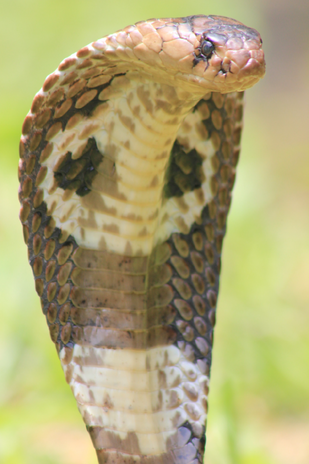
Unraveling the Geographic Variations in Sri Lankan Cobra Venom
Snakebites can be a serious threat in many countries, and the venom of the cobra species Naja naja can have different effects depending on where the snakes are found. We wanted to study the venom of Sri Lankan cobras to see if there were any differences in how it affects living organisms.
To do this, we injected small amounts of cobra venom into mice and observed how it affected their vital organs and muscle tissues. We found that the venom had varying levels of toxicity in different regions of Sri Lanka. In the Northern and Central regions, the venom was especially harmful to the mice's muscle tissues and caused a lot of inflammation and cell damage. In the Central region, the venom also had a strong effect on the mice's hearts. On the other hand, the venom from the Western, Southern, and Sabaragamuwa regions had slightly different effects, with varying levels of toxicity.
This study provides important evidence that the venom of Sri Lankan cobras can have different effects depending on where the snakes are found. Understanding these variations in venom composition can help us develop better treatments for snakebite victims and protect people from the dangers of these venomous snakes.
Dissanayake, D. S. B., Thewarage, L. D., Waduge, R. N., Ranasinghe, J. S. G., Kularatne, S. A. M., & Rajapakse, R. P. V. J. (2018). The venom of spectacled cobra (Elapidae: Naja naja): In vitro study from distinct geographical origins in Sri Lanka. Journal of Toxicology, 2018, 7358472.
Snakebites can be a serious threat in many countries, and the venom of the cobra species Naja naja can have different effects depending on where the snakes are found. We wanted to study the venom of Sri Lankan cobras to see if there were any differences in how it affects living organisms.
To do this, we injected small amounts of cobra venom into mice and observed how it affected their vital organs and muscle tissues. We found that the venom had varying levels of toxicity in different regions of Sri Lanka. In the Northern and Central regions, the venom was especially harmful to the mice's muscle tissues and caused a lot of inflammation and cell damage. In the Central region, the venom also had a strong effect on the mice's hearts. On the other hand, the venom from the Western, Southern, and Sabaragamuwa regions had slightly different effects, with varying levels of toxicity.
This study provides important evidence that the venom of Sri Lankan cobras can have different effects depending on where the snakes are found. Understanding these variations in venom composition can help us develop better treatments for snakebite victims and protect people from the dangers of these venomous snakes.
Dissanayake, D. S. B., Thewarage, L. D., Waduge, R. N., Ranasinghe, J. S. G., Kularatne, S. A. M., & Rajapakse, R. P. V. J. (2018). The venom of spectacled cobra (Elapidae: Naja naja): In vitro study from distinct geographical origins in Sri Lanka. Journal of Toxicology, 2018, 7358472.
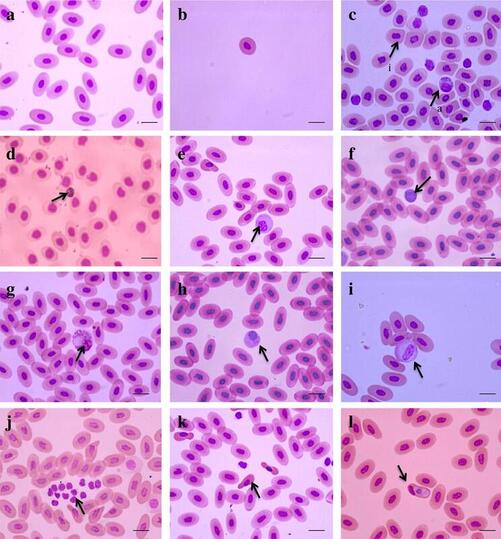
Hematological Profile of Wild Spectacled Cobras in Sri Lanka: A Diagnostic Tool for Conservation
In veterinary medicine and wildlife conservation, studying the blood of animals is crucial for understanding their health and well-being. However, such studies have been overlooked in Sri Lanka, particularly for reptiles like the spectacled cobra. In this research, we aimed to fill this gap by studying the blood of wild spectacled cobras in Sri Lanka.
We collected blood samples from 30 cobras (18 males and 12 females) to analyze various hematological parameters. The results showed some interesting differences between males and females. For instance, male cobras had higher red and white blood cell counts, higher hematocrit (PCV), and more hemoglobin and plasma protein than females.
We also noticed variations in hematological and plasma biochemical values among different populations of the cobras living in different regions of Sri Lanka. The good news is that we did not find any intracellular parasites in the studied specimens, which is a positive sign for their health. Our study provides valuable reference ranges for hematological values in adult spectacled cobras in Sri Lanka. This information will be essential in assessing the health of these magnificent snakes and diagnosing potential diseases in wild populations. By understanding their blood profiles better, we can better protect and conserve these important reptiles in their natural habitats.
Dissanayake, D. S. B., Thewarage, L. D., Manel Rathnayake, R. M. P., Kularatne, S. A. M., Ranasinghe, J. S. G., & Jayantha Rajapakse, R. P. V. (2017). Hematological and plasma biochemical parameters in a wild population of Naja naja (Linnaeus, 1758) in Sri Lanka. Journal of Venomous Animals and Toxins including Tropical Diseases, 23, 8.
In veterinary medicine and wildlife conservation, studying the blood of animals is crucial for understanding their health and well-being. However, such studies have been overlooked in Sri Lanka, particularly for reptiles like the spectacled cobra. In this research, we aimed to fill this gap by studying the blood of wild spectacled cobras in Sri Lanka.
We collected blood samples from 30 cobras (18 males and 12 females) to analyze various hematological parameters. The results showed some interesting differences between males and females. For instance, male cobras had higher red and white blood cell counts, higher hematocrit (PCV), and more hemoglobin and plasma protein than females.
We also noticed variations in hematological and plasma biochemical values among different populations of the cobras living in different regions of Sri Lanka. The good news is that we did not find any intracellular parasites in the studied specimens, which is a positive sign for their health. Our study provides valuable reference ranges for hematological values in adult spectacled cobras in Sri Lanka. This information will be essential in assessing the health of these magnificent snakes and diagnosing potential diseases in wild populations. By understanding their blood profiles better, we can better protect and conserve these important reptiles in their natural habitats.
Dissanayake, D. S. B., Thewarage, L. D., Manel Rathnayake, R. M. P., Kularatne, S. A. M., Ranasinghe, J. S. G., & Jayantha Rajapakse, R. P. V. (2017). Hematological and plasma biochemical parameters in a wild population of Naja naja (Linnaeus, 1758) in Sri Lanka. Journal of Venomous Animals and Toxins including Tropical Diseases, 23, 8.
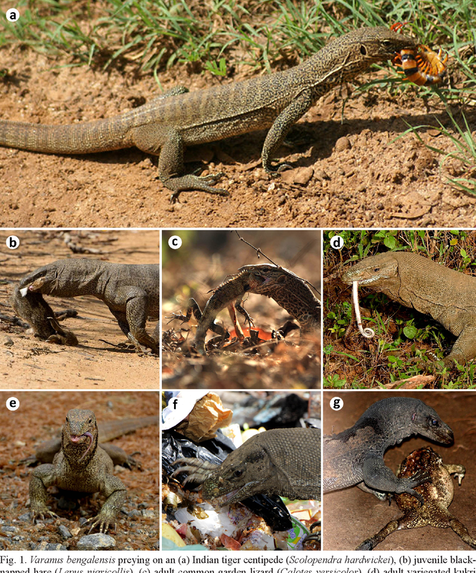
A Versatile Predator: Feeding Ecology of the Bengal Monitor in Sri Lanka
The Bengal monitor, one of the largest lizards in Sri Lanka, is an adaptable and versatile predator. It is well-suited to living in different types of habitats, from urban to rural areas and various climate zones.
In our study, we wanted to understand what the Bengal monitor eats and its role in the food chain across different environments in Sri Lanka. We observed the lizard in the wild, gathered information from existing research, and talked to other biologists to get a complete picture.
We discovered that the Bengal monitor is not picky when it comes to food. It preys on a wide range of vertebrates, including mammals, birds, reptiles, amphibians, and even fishes. It also scavenges for road-killed animals and feeds on rotting fruits and vegetables. Interestingly, despite being mostly terrestrial, the Bengal monitor also hunts aquatic prey and shows a preference for introduced and threatened species.
On the other hand, the Bengal monitor is not without its own predators. We found that it can fall victim to 24 different vertebrate species, including mammals, birds, and reptiles, especially when it is still young. The most surprising finding was that the Bengal monitor's diet and predator-prey relationships remained consistent across different landscapes, from urban to rural areas, and various climate zones in Sri Lanka. Overall, our study sheds light on the feeding habits and ecological role of the Bengal monitor in Sri Lanka, showing how this versatile predator plays a crucial part in the local ecosystem.
Karunarathna, S., Surasinghe, T., Dissanayake, D. S. B., Botejue, M., Gabadage, D., & Madawala, M. (2017). Dietary habits and the predators of the Bengal monitor Varanus bengalensis in Sri Lanka. Biawak, 11(1), 28-39.
The Bengal monitor, one of the largest lizards in Sri Lanka, is an adaptable and versatile predator. It is well-suited to living in different types of habitats, from urban to rural areas and various climate zones.
In our study, we wanted to understand what the Bengal monitor eats and its role in the food chain across different environments in Sri Lanka. We observed the lizard in the wild, gathered information from existing research, and talked to other biologists to get a complete picture.
We discovered that the Bengal monitor is not picky when it comes to food. It preys on a wide range of vertebrates, including mammals, birds, reptiles, amphibians, and even fishes. It also scavenges for road-killed animals and feeds on rotting fruits and vegetables. Interestingly, despite being mostly terrestrial, the Bengal monitor also hunts aquatic prey and shows a preference for introduced and threatened species.
On the other hand, the Bengal monitor is not without its own predators. We found that it can fall victim to 24 different vertebrate species, including mammals, birds, and reptiles, especially when it is still young. The most surprising finding was that the Bengal monitor's diet and predator-prey relationships remained consistent across different landscapes, from urban to rural areas, and various climate zones in Sri Lanka. Overall, our study sheds light on the feeding habits and ecological role of the Bengal monitor in Sri Lanka, showing how this versatile predator plays a crucial part in the local ecosystem.
Karunarathna, S., Surasinghe, T., Dissanayake, D. S. B., Botejue, M., Gabadage, D., & Madawala, M. (2017). Dietary habits and the predators of the Bengal monitor Varanus bengalensis in Sri Lanka. Biawak, 11(1), 28-39.
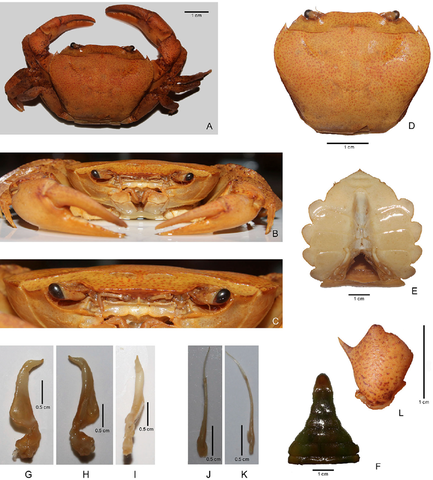
Expanding the Range of the Endemic Freshwater Crab in Sri Lanka
We discovered some exciting news about a special crab that is unique to Sri Lanka. The Oziothelphusa mineriyaensis, a freshwater crab, was previously known to live in just two areas in the dry zone of the country. But in our study, we found five new places where this crab lives!
Our findings show that the Oziothelphusa mineriyaensis now has a much larger habitat area, going from 168 square kilometers to an impressive 1467 square kilometers. The new localities we identified are quite far from the previously known areas, up to 89 kilometers away!
This discovery is essential for the conservation of this endangered species. With this new information, we can better understand where these crabs live and take steps to protect their natural habitats in Sri Lanka.
De Zoysa, H. K. S., Samarasinghe, D. P., Dissanayake, D. S. B., Wellappuliarachchi, S. M., & Wickramasinghe, S. (2017). Range extension of Oziothelphusa mineriyaensis Bott, 1970 (Decapoda, Gecarcinucidae) in North Central Province, Sri Lanka. Check List, 13(5), 443–446.
We discovered some exciting news about a special crab that is unique to Sri Lanka. The Oziothelphusa mineriyaensis, a freshwater crab, was previously known to live in just two areas in the dry zone of the country. But in our study, we found five new places where this crab lives!
Our findings show that the Oziothelphusa mineriyaensis now has a much larger habitat area, going from 168 square kilometers to an impressive 1467 square kilometers. The new localities we identified are quite far from the previously known areas, up to 89 kilometers away!
This discovery is essential for the conservation of this endangered species. With this new information, we can better understand where these crabs live and take steps to protect their natural habitats in Sri Lanka.
De Zoysa, H. K. S., Samarasinghe, D. P., Dissanayake, D. S. B., Wellappuliarachchi, S. M., & Wickramasinghe, S. (2017). Range extension of Oziothelphusa mineriyaensis Bott, 1970 (Decapoda, Gecarcinucidae) in North Central Province, Sri Lanka. Check List, 13(5), 443–446.
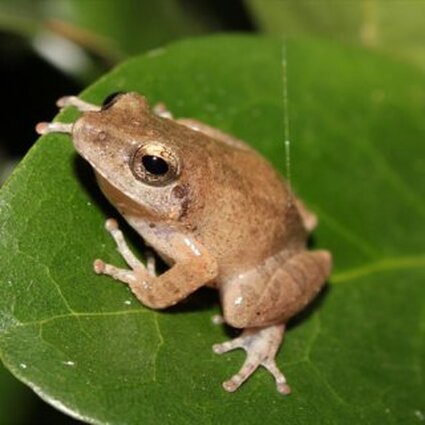
Habitat Preference of the Endemic Shrub Frog in Mihintalae, Sri Lanka
Mihintalae, a place in Sri Lanka, is home to a special frog called Pseudophilautus regius. We wanted to understand where these frogs like to live, so we studied six different habitats like forests, ponds, rocks, and gardens.
During our study, we counted 143 P. regius frogs. Most of them (53%) were found at the edges of forests, while some (23%) liked to live in shrub lands and home gardens (20%). Surprisingly, we didn't find any frogs in the rocky areas. We noticed that the number of frogs increased when there was more rain in the forests, but in home gardens, it was the opposite - the number of frogs decreased during rainy days.
This information helps us understand where these frogs like to live and how their population changes with the seasons. More research is needed to estimate their population size and plan conservation efforts to protect them if needed.
Dissanayake, D. S. B., & Wellappuliarachchi, S. M. (2012). Habitat preferences of the endemic shrub frog Pseudophilautus regius (Manamendra–Arachchi & Pethiyagoda 2005) at Mihintale Sanctuary, Sri Lanka. Amphibian and Reptile Conservation, 5(2), 114-124.
Mihintalae, a place in Sri Lanka, is home to a special frog called Pseudophilautus regius. We wanted to understand where these frogs like to live, so we studied six different habitats like forests, ponds, rocks, and gardens.
During our study, we counted 143 P. regius frogs. Most of them (53%) were found at the edges of forests, while some (23%) liked to live in shrub lands and home gardens (20%). Surprisingly, we didn't find any frogs in the rocky areas. We noticed that the number of frogs increased when there was more rain in the forests, but in home gardens, it was the opposite - the number of frogs decreased during rainy days.
This information helps us understand where these frogs like to live and how their population changes with the seasons. More research is needed to estimate their population size and plan conservation efforts to protect them if needed.
Dissanayake, D. S. B., & Wellappuliarachchi, S. M. (2012). Habitat preferences of the endemic shrub frog Pseudophilautus regius (Manamendra–Arachchi & Pethiyagoda 2005) at Mihintale Sanctuary, Sri Lanka. Amphibian and Reptile Conservation, 5(2), 114-124.
© 2017 by Duminda Dissanayake Last update 2023-07-22
